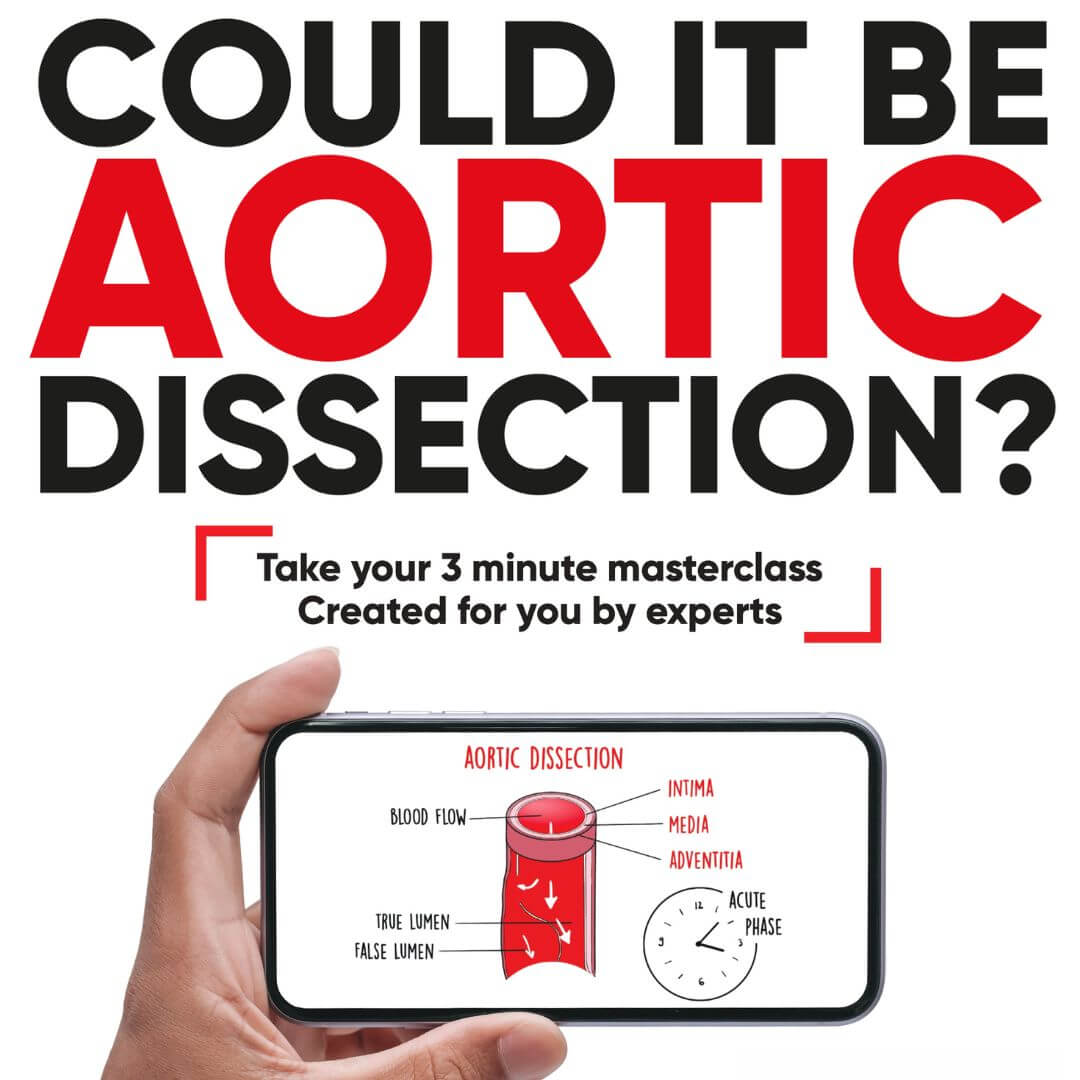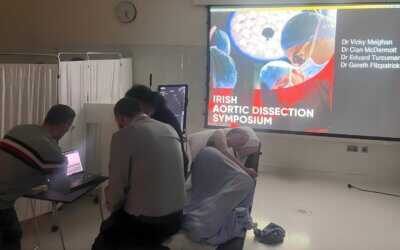Acute aortic dissection is one of those medical conditions that challenge even the most experienced emergency medical specialists. Recognising this challenge, the Aortic Dissection Charity partnered with The European Society for Emergency Medicine to present this webinar to improve medical professionals’ understanding of acute aortic dissection and its management.
Dr Gregor Prosen, EUSEM’s Education Committee Chair, moderated the webinar which featured a distinguished line-up of experts in the field, each focusing on a specific element of aortic dissection. Here we summarise some of the key points. Please also watch the full course on the EUSEM Academy.
Professor Matt Reed
The Gravity of Misdiagnosis
Professor Matt Reed opened the session by sharing a sobering case report of a patient who faced a tragic death due to misdiagnosis. Initially identified as suffering from an acute embolus, the patient underwent surgery to remove a thrombus. However, he later died from cardiac arrest, caused by the actual culprit – an undiagnosed aortic dissection. This example served as an immediate reminder of the severe consequences that misdiagnoses can have in cases of aortic dissection.
Identifying Common Pitfalls in Diagnosis
Recent data shows that a quarter of aortic dissection patients aren’t correctly diagnosed until 24 hours post-admission, a significant time gap in a condition requiring immediate intervention. What complicates matters is that aortic dissection can masquerade as other conditions, such as acute coronary syndrome or renal colic.
Three key reasons for these misdiagnoses were highlighted:
- clinicians not including aortic dissection in their differential diagnosis
- settling too quickly on a different diagnosis
- patients who don’t display the classic symptoms of the condition
Statistical Challenges in Diagnosing Aortic Dissection
Delving into the epidemiology, the talk revealed the diagnostic dilemma clinicians often face: aortic dissection represents just a small fraction of conditions presenting with chest, back, or abdominal pain in the emergency department. The term “low signal and high noise” is used to explain the difficulty in identifying this condition.
Data-Driven Insights and Recommendations
A joint study between NHS Lothian and Frimley Health NHS Foundation Trust found 43 missed aortic dissection cases over a decade. The majority of these misdiagnosed cases initially presented with chest pain, while one in six showed neurological symptoms or loss of consciousness. This data underlines the need for heightened awareness in diagnosis. To improve detection rates, the advice is for medical practitioners to include aortic dissection in their differential diagnoses, particularly when confronted with severe or sudden onset symptoms.
Tools like the Aortic Dissection Detection Risk Score (ADD-RS) and D-dimer tests have some value, but they’re not sufficiently sensitive or specific on their own to be reliably used for ruling in or out the condition. There is an ongoing need for research aimed at reducing misdiagnoses and Matt recommended its inclusion in differential diagnoses, particularly when symptoms manifest suddenly. Both statistical data and clinical experiences make a compelling case for the urgent need to refine UK and Irish emergency medicine diagnostic procedures around potential aortic dissection.
Dr Eva Göncz
Immediate Management of Aortic Dissection
Dr Göncz addressed the complexities of diagnosing aortic dissection and discussed the American and Canadian clinical decision-making tools designed to identify risk factors and red flags, pointing out that these are not foolproof and that clinicians must be proactive in considering aortic dissection as a possible diagnosis, and highlighting the range of conditions that could predispose people to aortic wall stress, thereby increasing their risk.
Initial Treatment Aims
Dr Göncz outlined key goals of immediate management, including slowing ventricular contraction velocity, minimising shear stress, and controlling blood pressure spikes. These objectives could be considered as current “best practice” approaches for treating aortic dissection patients in an emergency setting.
This session covered a comprehensive approach to the urgencies and intricacies involved in managing acute aortic dissection. From the initial diagnostic hurdles to a multidisciplinary treatment approach, illuminating the complexities of treating this life-threatening condition.
Dr Göncz urged healthcare providers to stay alert, be agile in diagnosis, and adhere to evidence-based immediate management goals to improve patient outcomes. The full recording of the webinar is available on the EUSEM Academy.
Dr Frederik Maximilian Schaefer
Presentation on Radiology’s Role in Aortic Dissection
Dr Schaefer, a senior consultant specialised in emergency radiology, stressed the essential role that radiology, particularly CT scanning, plays in the accurate diagnosis of aortic dissection. The emergency nature of AD cases requires high sensitivity and specificity in imaging to guide prompt and accurate management.
Comparison of Diagnostic Tools
CT Scan Key Considerations
Dr Schaefer outlined the key considerations of CT scanning involved in diagnosing aortic dissection:
- Unenhanced Scan. Valuable for detecting abnormalities in the aortic wall or displacements of calcifications.
- Arterial Scan. Essential for detailed visualisation of the aorta and its branches, and for identifying the presence of intimal flaps or active bleeding.
- Venous Scan. Important for assessing organ perfusion.
- ECG-Gating. Preferred when possible, to minimise artifacts related to cardiac motion and to obtain accurate measurements.
- Radiation. Repeated CT scans pose the risk of significant radiation exposure with long term cancer risk.
- Contrast Agents. Necessary for detailed images but can pose risks, especially in patients with renal issues.
- MRI. Offers high sensitivity and specificity but is not practical for emergency diagnosis due to longer scan times and restrictions like incompatible pacemakers and other routinely used monitoring equipment.
Dr Schaefer emphasised that CT scans remain the gold standard for diagnosing aortic dissection despite concerns about radiation and contrast agents. He strongly advocated for at least biphasic, if not triphasic, CT scans in suspected cases and recommended the use of ECG-gating when available.
The EM Monthly session provided a comprehensive overview of the complexities and challenges in diagnosing and managing aortic dissection. Ongoing research and interdisciplinary collaboration are critical for improving patient outcomes for this challenging cardiovascular condition.




